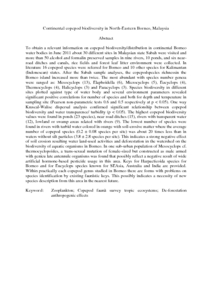Citation
Alekseev, Victor R. and M. Yusoff, Fatimah and Fefilova, Elena B.
(2016)
Continental copepod biodiversity in North-Eastern Borneo, Malaysia.
Arthropoda Selecta, 25 (2).
pp. 183-197.
ISSN 0136-006X
Abstract
To obtain a relevant information on copepod biodiversity/distribution in continental Borneo water bodies in June 2011 about 30 different sites in Malaysian state Sabah were visited and more than 50 alcohol and formalin preserved samples in nine rivers, 10 ponds, and six near-road ditches and canals, rice fields and forest leaf litter environment were collected. In literature 16 copepod species were referred for Borneo and 10 other species for Kalimantan (Indonesean) states. After the Sabah sample analyses, the copepodspecies richnessin the Borneo island increased more than twice. The most abundant with species number genera were ranged as: Mesocyclops (13), Elaphoidella (6), Microcyclops (5), Eucyclops (4), Thermocyclops (4), Halicyclops (3) and Paracyclops (3). Species biodiversity in different sites plotted against type of water body and several environment parameters revealed significant positive correlations for number of species and both for depth and temperature in sampling site (Pearson non-parametric tests 0.6 and 0.5 respectively at p < 0.05). One way Kruscal-Walise dispersal analysis confirmed significant relationship between copepod biodiversity and water transparence/ turbidity (p < 0.05). The highest copepod biodiversity values were found in ponds (23 species), near road ditches (15), rivers with transparent water (12), lowland or swamp areas related with rivers (9). The lowest number of species were found in rivers with turbid water colored in orange with soil-erosive matter where the average number of copepod species (0.2 ± 0.08 species per site) was about 20 times less than in waters without silt particles (3.8 ± 2.8 species per site). This indicates a strong negative effect of soil erosion resulting water land-used activities and deforestation in the watershed on the biodiversity of aquatic organisms in Borneo. In one sub-urban population of Mesocyclops cf. thermocyclopoides, a trans-sexual mutation of female-sized but constructed as male armed with genicu late antennule organisms was found that possibly reflect a negative result of wide artificial hormone-based pesticide usage in this area. Keys for Harpacticoida species for Borneo and for Eucyclops species known for SEAsia, Australia and India are provided. Within practically each copepod genus studied in Borneo there are forms with problems on species identification by existing faunistic keys. This possibly indicates a necessity of new species description from this area in the nearest future.
Download File
![[img]](http://psasir.upm.edu.my/55375/1.hassmallThumbnailVersion/Continental%20copepod%20biodiversity%20in%20North-Eastern%20Borneo%2C%20Malaysia.pdf)  Preview |
|
PDF (Abstract)
Continental copepod biodiversity in North-Eastern Borneo, Malaysia.pdf
Download (6kB)
| Preview
|
|
Additional Metadata
Actions (login required)
 |
View Item |

